
It is difficult to judge the development of knowledge in terms of the technologies that it has helped to create. But, in the century that just passed by, most people would agree that the two technologies that have had the most effects on our lives have been the Laser and the Transistor.
Laser is an acronym that stands for Light Amplification by the Stimulated Emission of Radiation. When an atom or molecule is given energy it is said to be excited. As a ball that is made to roll up a hill stops and rolls back down, all processes in nature prefer to go back to their lowest energy state. So, excited atoms and molecules tend to de-excite, typically, by emitting electromagnetic radiation, or light. A collection of these excited atoms will radiate in arbitrary and random directions. In a laser, however, they are forced to do this in a preferred direction. So, lasers produce light output that is unidirectional, i.e. a pencil of light, instead of a diverging cone. In addition, instead of de-excitations at random times, lasers force the atoms to de-excite coherently and in unison through the process of stimulated emission. It is this property of laser light that makes it truly special.

Students at Union College working with our argon ion and dye lasers
The history of the invention of the laser is rather interesting, and not without some controversy. It is generally agreed by the scientific community, that it was Albert Einstein's theoretical prediction of the process now known as "stimulated emission" that opened the possibility for the invention of the laser. It is also well accepted that the first working laser, a ruby laser, was invented in 1960 by Theodore Maiman, a physicist at Hughes Research Laboratories. But it is not as universally agreed on as to who should be credited with the original idea for the laser. In 1951 Charles H. Townes, a physicist at Columbia University, built a MASER (Microwave Amplification by the Stimulated Emission of Radiation) which used Einstein's prediction to generate microwaves of a single wavelength. A few years later Townes and a colleague at Bell Laboratories, Arthur Schawlow, published a scientific paper in a physics journal outlining their ideas for the development of a laser. In 1964 Townes and two Soviet (Russian) physicists jointly shared the Nobel Prize for the invention of the laser. But the legal courts have granted four patents for this invention to Gordon Gould, who independently of Townes and Schawlow had come up with the important ideas for making a laser. It is noteworthy to mention that Gould is a graduate of our physics department - Union Class of 1941! History is often full of intrigue. For one historical perspective, visit the Web site at Bell Laboratories on the history of lasers. For another, see the recently published book: Laser: The Inventor, the Nobel Laureate, and the Thirty-Year Patent War by Nick Taylor.
Brief History of Optics
The earliest writings on light date back to the 5th century BC in China detailing empirical discussions on the reflection of light from mirrors - both plane (flat) and curved. The earliest western writing on optics dates to around 300 BC in the works of Euclid. He recognized that light travels in a straight line in a uniform medium such as air or water, but, following the ideas of Plato, the Greeks thought that "rays" of light originated in our eyes and travel outward to illuminate objects and let us see them. In other words, if you did not look at an object - "cast your eye upon it" - and illuminate it, you could not see it. This idea is known as a "tactile" theory of light and persisted for almost 1300 years.
These ideas were abandoned around 900 AD when a famous Arabian scientist Al Hazem worked out, through experiment and theory, the mathematical analysis of the reflection of light from mirrors and the bending on light (refraction) on crossing the boundary between two different media (such as air and water). He wrote many books on various scientific subjects, but his greatest work was a 7 volume study of optics. It was not published in Europe until the late 1500's and was a direct influence on further developments.
Diagram of the human eye and the cover plate of Optics by Al Hazem
Major developments next occurred in the 1600's in Europe in the work of Descartes (light travels through an elastic medium in space termed the aether - now known to be empty space), Galileo (the invention of the telescope), Snell (the law of refraction), Fermat (unified laws of reflection and refraction) and most importantly Newton, who in 1665 published his book on Optics.
Newton was perhaps the most influential scientist ever until Albert Einstein. When a student at Cambridge University at age 23 the great plague closed the university for 18 months. Newton worked at home in that time developing calculus, his universal theory of gravity, a theory of color, as well as an entire work on Optics. Newton believed that light behaved as a corpuscle, or particle, traveling in straight lines and casting geometric shadows just as projectiles would. Because of his extreme influence, this idea took over a hundred years to dispel.
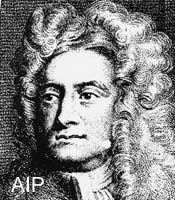

Newton Einstein Red, Blue and Green color mixing
During the next 100 years or so other scientists, notably Robert Hooke, Christian Huygens, and Thomas Young, developed alternate theories of light. They believed that light behaved as a wave, in many ways similar to sound. Young, a scientist and physician and sometimes known as the "last man who knew everything" (he studied math, physics, medicine, chaired the National Philosophy Department at the Royal Institute in London, contributed to botany, philosophy, physiology, languages - he translated hieroglyphics using the Rosetta Stone - and to physics), was the first to explain the phenomenon of interference in waves - discovered by Hooke over 100 years earlier. We will study this phenomenon when we study waves. The notion that light was a wave, rather than a corpuscle. was not generally accepted at the time because of Newton's reputation.
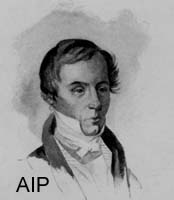
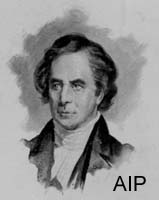
Fresnel Arago
In 1818 Augustin Fresnel was presenting a prize memoir on a wave theory of light at the French Academy of Sciences before a distinguished panel of scientists, including Simeon Poisson. After his presentation, as the story goes, Poisson interjected saying that this was utter nonsense since if a beam of light were incident on a solid disk, instead of there being a circular shadow, Fresnel's theory implied that there should be a bright spot at the center of that shadow. Without having done the experiment Poisson dismissed this idea as impossible. Dominique Arago, who was also on the panel, did the experiment and indeed surprisingly witnessed a bright spot at the center of the geometric shadow and essentially overnight the wave theory of light became accepted in the scientific community.
(left) A magnetized ball bearing is held by a needle in an expanded laser beam (not visible); (right) The shadow of the ball bearing on a distant screen shows the famous Poisson spot at its center. Diffracted light appears as a bright spot at the center of the shadow. This experiment gave fresh birth to the wave theory of light in the 1800's.
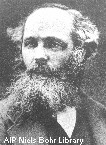
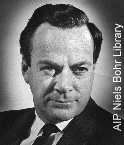
Maxwell Feynman
In 1865 James Clerk Maxwell made a pivotal discovery and synthesis of previous work, summarizing much of what was known of electricity, magnetism and optics in a simple set of four equations, representing a complete theory of the science of electromagnetism. Aside from gravity, this theory has stood for many years as a total theory of the macroscopic (non-quantum mechanical) world. It has been improved on in the last century through the work of many scientists into the theory known as Quantum Electrodynamics (QED). The current off-Broadway play with this title is about one of the founders of this theory, Richard Feynman.
